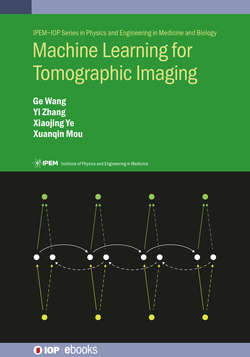Читать книгу Machine Learning for Tomographic Imaging - Professor Ge Wang - Страница 10
На сайте Литреса книга снята с продажи.
Author biographies
ОглавлениеGe Wang
Ge Wang, PhD wangg6@rpi.edu; https://www.linkedin.com/in/ge-wang-axis
Ge Wang is the Clark and Crossan Endowed Chair Professor and the Director of the Biomedical Imaging Center, Rensselaer Polytechnic Institute, Troy, NY, USA. He published the first spiral/helical cone-beam/multi-slice CT paper in 1991 and has since then systematically contributed over 100 papers on theory, algorithms, artifact reduction, and biomedical applications in this area of CT research. Currently, over 100 million medical CT scans are carried out yearly with a majority in the spiral/helical cone-beam/multi-slice mode. Dr Wang’s group developed interior tomography theory and algorithms to solve the long-standing ‘interior problem’ for high-fidelity local reconstruction, establishing the feasibility of omni-tomography (‘all-in-one’) with simultaneous CT-MRI as an example. He initiated the area of bioluminescence tomography. He has produced over 480 journal publications, covering diverse imaging-related topics and receiving a high number of citations and academic awards. His results have been featured in Nature, Science, PNAS, and news media. In 2016, he published the first perspective on deep-learning-based tomographic imaging as a new direction of machine learning and a Nature Machine Intelligence paper on the superiority of deep learning over iterative reconstruction in collaboration with his colleagues. His team has been continuously well-funded by federal agencies and imaging companies. His interests include CT, MRI, optical tomography, multi-modality fusion, artificial intelligence, and machine learning. He is the lead Guest Editor for five IEEE Transactions on Medical Imaging special issues, the founding Editor-in-Chief of the International Journal of Biomedical Imaging, a Board Member of IEEE Access, and an Associate Editor of IEEE Transactions on Medical Imaging (TMI) (recognized as an ‘Outstanding Associate Editor’), Medical Physics, and Machine Learning Science and Technology. He is Fellow of IEEE, SPIE, OSA, AIMBE, AAPM, AAAS and NAI.
Yi Zhang
Yi Zhang, PhD yzhang@scu.edu.cn
Yi Zhang received his bachelor’s, master’s, and PhD degrees from the College of Computer Science, Sichuan University, Chengdu, China, in 2005, 2008, and 2012, respectively. From 2014 to 2015, he was with the Department of Biomedical Engineering, Rensselaer Polytechnic Institute, Troy, NY, USA, as a Postdoctoral Researcher. He is currently an Associate Professor with the College of Computer Science, Sichuan University, and is the Dean of the Software Engineering Department. His research interests include medical imaging, compressive sensing, and deep learning. He authored more than 60 papers in the field of medical imaging. His group published the first peer-reviewed journal paper on deep learning based low-dose CT and subsequently published more than 20 papers in this rapidly expanding area. These papers were published in several leading journals, including IEEE Transactions on Medical Imaging, IEEE Transactions on Computational Imaging, Medical Image Analysis, European Radiology, Optics Express, etc, and reported by the Institute of Physics (IOP) and during the Lindau Nobel Laureate Meeting. He received major funding from the National Key R&D Program of China, the National Natural Science Foundation of China, and the Science and Technology Support Project of Sichuan Province, China. He is a Guest Editor of the International Journal of Biomedical Imaging, Sensing and Imaging, and an Associate Editor of IEEE Access. He is a Senior Member of IEEE.
Xiaojing Ye
Xiaojing Ye, PhD xye@gsu.edu
Dr Xiaojing Ye is an Associate Professor with the Department of Mathematics and Statistics at Georgia State University, Atlanta, USA. Prior to joining Georgia State University in 2013, he was a Visiting Assistant Professor with the School of Mathematics at the Georgia Institute of Technology, USA. He received his bachelor’s degree in mathematics from Peking University in 2006, and a master’s degree in statistics and a PhD degree in mathematics from the University of Florida, USA, in 2009 and 2011, respectively. His research focuses on applied and computational mathematics, in particular variational methods for imaging problems, numerical optimization and analysis, and computational problems in machine learning.
Xuanqin Mou
Xuanqin Mou, PhD xqmou@xjtu.edu.cn
Dr Xuanqin Mou received his bachelor’s, master’s, and PhD degrees from Xi’an Jiaotong University, China. Since 1987, he has been a faculty member with Xi’an Jiaotong University and was prompted to Full Professor in 2002. Currently, he is the Director of the National Data Broadcasting Engineering and Technology Research Center, and the Director of the Institute of Image Processing and Pattern Recognition. He served on the Twelfth Expert Evaluation Committee for the National Natural Science Foundation of China. He is currently on the Executive Committee of the China Society of Image and Graphics, the Executive Committee of the Chinese Society for Stereology, also serves as the Deputy Director of the CT Committee of the Chinese Society for Stereology. He was on the editorial boards of several academic journals and technical program committee for many international conferences. In 2017, Dr Mou co-chaired the Fourteenth Fully Three-Dimensional Image Reconstruction in Radiology and Nuclear Medicine Conference at Xi’an Jiaotong University, which is the prime conference in the field of CT/PET/SPECT image reconstruction research and development. His interests include x-ray medical imaging, CT reconstruction, observer models, perceptual quality assessment, and video coding. He published over 200 peer-reviewed journal and conference papers, and holds over ten Chinese patents as the principle inventor. He received a Second-class Award for Invention issued by the Ministry of Education of China as the principal investigator, and several other awards. As the principal investigator, he received 16 governmental grants and 20 industrial funds.
Art rendering by Ge Wang, July 2019. Panda symbolizes digital and biological technologies, being binary and adorable. As is well known, it is racially representative, being black and white, as well as oriental. The Yin–Yang pattern suggests entanglement of information, and hope for the future.
